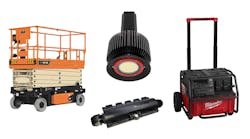John Dickinson may be a systems engineer/electrician at a private college in Philadelphia, but it didn't take someone with his advanced knowledge to realize that one of the university's buildings had some major electrical issues. “This particular facility had lamps that were burning out frequently,” says Dickinson. “It didn't matter what kind of lamp (HID, quartz, or incandescent), bulbs and ballasts were burning out left and right. Electronic equipment and relays — just about every type of electrical equipment you can think of — were also burning out. We knew we had a problem; we just needed to identify it.”
Enter the Voltage Performance Monitor (VPM) from Ideal Industries, Sycamore, Ill. Designed to combat the potentially costly effects of poor voltage quality, the VPM identifies voltage conditions that can damage equipment or cause equipment failures. For use on 100V to 240V single-phase circuits, the unit plugs directly into an outlet to “see” what the equipment receives in the form of power. According to Ideal, the tester informs the technician if problematic voltage events are occurring and logs the time, duration, and severity of the event without the need of a computer or special training.
“We designed the VPM to be an extremely powerful device that did not need a computer, didn't need software, and didn't need someone with expertise to determine whether or not there were power quality problems on a branch circuit,” explains Brian Blanchette, Ideal's director of power quality. “The meter puts the brains in the box to give electricians and facilities managers an inexpensive way of determining power quality on their own.”
Because the monitor logs only those events that exceed designed tolerances, including voltage sags, swells, impulses, and excessive total harmonic distortion, determining if equipment failure is related to a voltage event is a straightforward process. “Ideally, a technician would plug the VPM into the wall, and leave it there for a week or so before coming back,” Blanchette says. “If the monitor reads all zeros across the top, then you don't have a power quality problem. It's as simple as that. There is nothing to download and nothing to analyze. If you see anything other than a zero on the screen, then you had an event that's critical.”
Time and severity of events are displayed on the VPM's bright OLED screen, and users can store up to 512 events in the unit's internal memory, which can then be reviewed either by category or chronological order. The event detail provides a time stamp with event magnitude and duration, while the impulse detail allows for fast response that catches positive and negative impulses up to 4kV. In addition, the unit allows a technician to verify the need for a UPS installation or a surge protective device, as well as confirm the protection provided by such equipment. It also gives users the ability to determine if voltage is stable enough to add a sensitive piece of equipment, such as computers, copiers, electronic lighting ballasts, medical equipment, and adjustable-speed drives.
“The best way I can describe this meter is to say that, for the cost, it's like a car's ‘check engine’ light,” Dickinson says. “It gives you an indication of what types of electrical events are occurring so you can take the next step. Using the VPM, we discovered that our facility has harmonics issues. At this point, we are going to hire a power quality company to perform an engineering study. We would not have known that we needed to do that without this meter. The VPM led us in the direction we needed to go.”
Pre-loaded with tolerance settings based on 15 internationally recognized standards — including ITIC, CBEMA, SEMI, and ANSI — users select the appropriate standard for the application, and the VPM logs those events while ignoring the rest. To meet specific needs, technicians can set their own custom thresholds. In addition to electricians, other potential users of the product include installation and service technicians, plant managers, building maintenance technicians, equipment manufacturers, and hospital/IT maintenance engineers.
Priced at $475, the Ideal Voltage Performance Monitor features plug adapters for operation in the United States, the United Kingdom, China, Australia, and Europe. A carrying case, a quick reference guide, and an instructional DVD also are included. For more information, visit www.idealindustries.com.
Product Specs
Operating range: 15V to 265V
Memory: 512 events
Sampling method: Continuous (128 samples per cycle)
Voltage accuracy: 1%
Impulse detection: 6μ, 4kV
THD: FFT calculation


